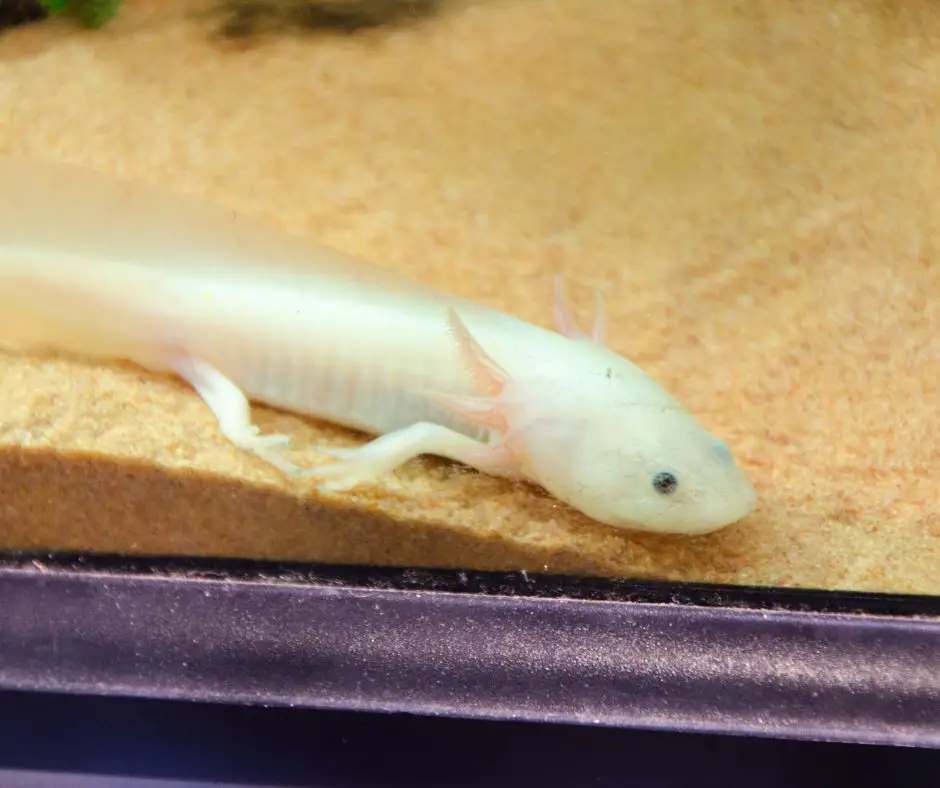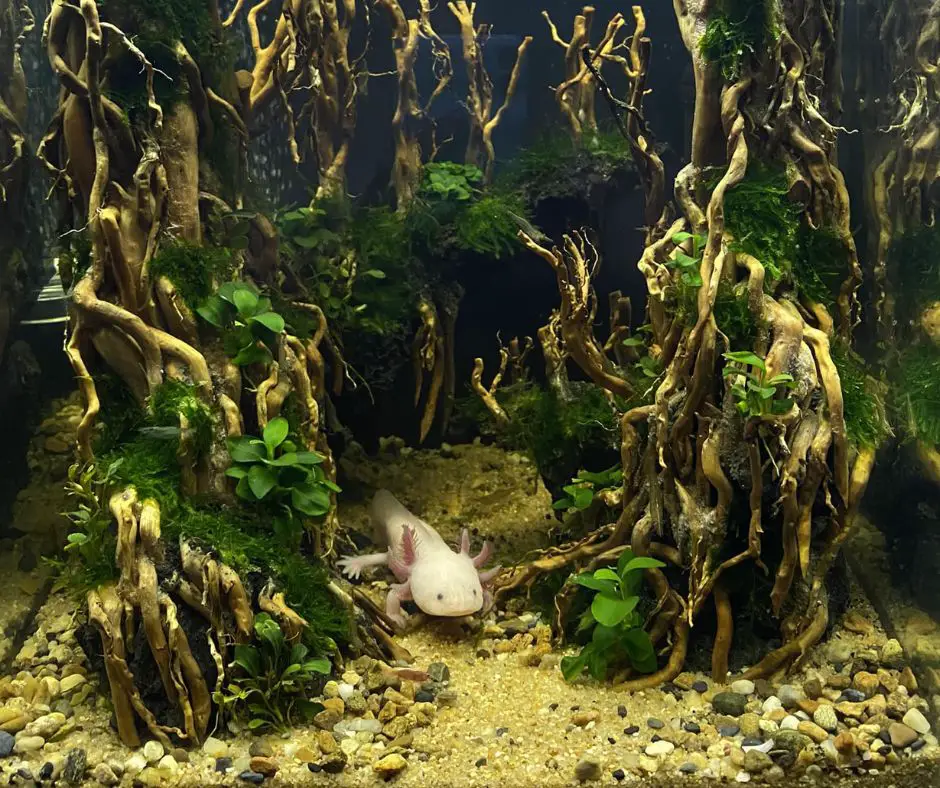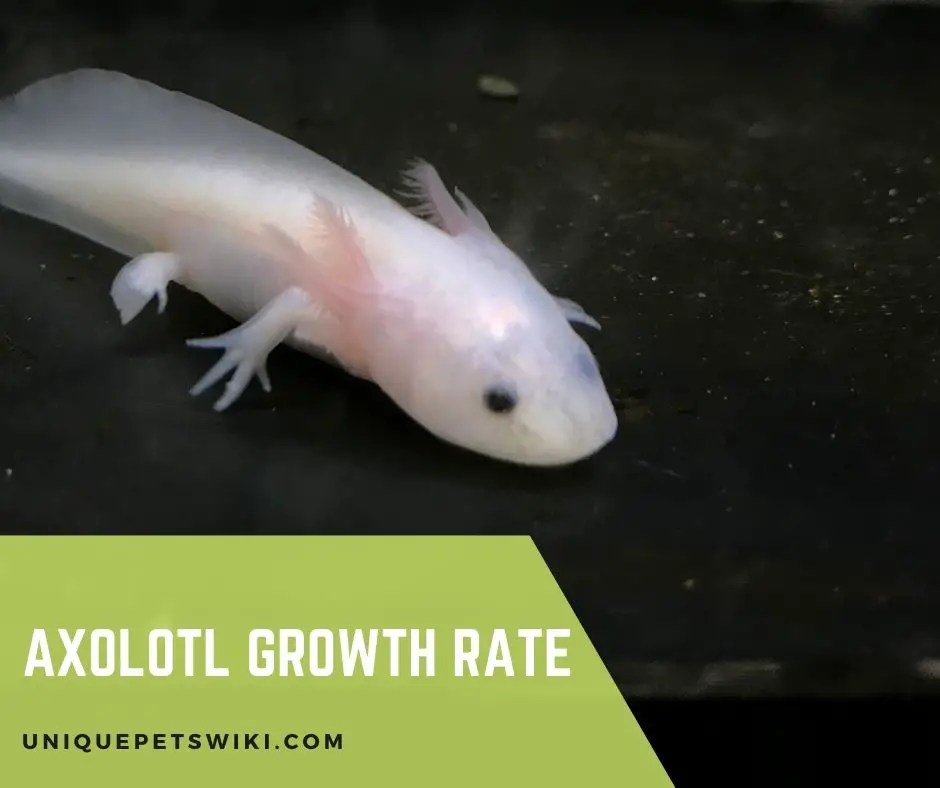Axolotls are one of the most unique and exotic aquatic pets that are fast becoming popular among aquatic hobbyists.
Naturally, as an axolotl owner, you may wonder about axolotl growth rate to ensure that your pet is growing normally.
It is also important to know exactly how fast axolotls grow so you can keep track of your pet’s health.
This article covers all these topics and more!
Contents
How Fast Do Axolotls Grow?
An axolotl’s growth rate depends on various factors. In general, an axolotl reaches maturity around the age of 2 years.
According to experts, fully grown axolotls reach a length of 30-45 cm or about 12 to 18 inches measured from the tip of their noses to the end of their tails. However, your axolotl’s exact measurements and growth rate will vary based on its environment and the care and effort you put into its husbandry.
| Lifecycle stage | Duration | Size |
| Stage 1: Small Egg | 14 days | 1.1-1.5 cm |
| Stage 2: Embryo | 3 days | 10-13 mm(roughly 0.5 inch) |
| Stage 2: Larva (Limbless) | 15 days | 10 mm – 2 cm(3/8 inch – 1 inch) |
| Stage 4: Young Larva Have Limb | 15 days – 5 months | 2 cm – 25 cm(1 inch – 8 inches) |
| Stage 5: Adult | 6 months – 24 months | 25 cm – 35 cm(8 inches – 18 inches) |

4 Factors Affect Axolotl Growth Rate
As mentioned earlier, an axolotl growth rate depends on various factors, and all axolotls will show a different rate of growth.
Some axolotls remain petite or small while others may grow up bulky. In general, you can expect your axolotl to attain full maturity and growth up to 1 ½ to 2 years of age (18-24 months)
So, how do you know if your pet is growing normally?
A good thumb rule is if your axolotl has attained 6-7 inches or 15-17 cm length by the age of 8-9 months, then it is showing a healthy or normal growth rate.
Some factors that affect your axolotl’s growth rate are the care and maintenance you provide, the water conditions, its age, genetics, and also the size of the tank.
Let us study these factors in detail:
Genetic
One of the major things that can affect the growth rate of your axolotl is genetics.
Even axolotls spawned from the same cluster of eggs may show different growth rates depending on genetics. If your axolotl’s parents were large, then it may be large although some larger axolotls may birth small-sized axolotls if the tank conditions are less-than-optimum.
Age
Your axolotl’s age will also determine its length. As mentioned before, most juvenile axolotls measure between 6-10 inches, and an adult should measure between 9-18 inches with the average being 12 inches. Your axolotl may attain full growth by 12-18 months although some specimens have been known to continue growing up to 24 months.
In general, though, most 2-year-old axolotls would have completed their growth cycle.
Habitat
A small tank can impede your axolotls’ growth. Even a baby axolotl needs a lot of space to swim and explore. This is essential for a normal growth rate.
If you want your axolotl to grow to a normal length of 12-18 inches, it is important to provide maximum tank space for them to swim in. This is why experts recommend a tank size of at least 60 cm (L) x 30 cm (W) to house a single axolotl.
Similarly, the water parameters can also impact your axolotl’s growth rate. If the ammonia levels are constantly high, your axolotl will be stressed and diseased. This can impede normal growth and development.
So, get into the habit of making regular water changes. This will keep your ammonia levels in control and help your axolotl thrive.
Tetra Aquarium 20 Gallon Fish Tank Kit
- Tetra Glass Aquariums are made in the USA and are built to last with scratch resistant glass
- The Tetra Aquarium comes loaded with an LED hood, that provides a natural daytime effect and a Whisper Filter that is whisper quiet while providing powerful, dependable water flow
- Artificial Plants add a unique, natural ocean feel while giving your fish a place to hide which reduces fish stress
- The Tetra Kit includes: one 20 Gallon Glass Aquarium, one LED hood, one Tetra Mini UL Heater, one Tetra Whisper 20 Filter, one artificial Boxwood Plant Mat, four artificial plants. Add gravel and fish to complete your aquarium
- Aquarium Dimensions: 24.2" L x 12.4" W x 16.7" H
Last update on 2022-12-29 / Affiliate links / Images from Amazon Product Advertising API
Feeding Schedule
Some other factors that affect an axolotl’s growth are its diet and feeding schedule.
- Poor or low-quality diets can result in dietary deficiencies which can impact the axolotl’s growth rate.
- Too much-frozen food and inadequate live food can result in nutritional deficiencies which can cause a slower-than-average growth rate.
Similarly, the right feeding schedule is also essential to maintain a proper growth rate.
- Both, underfeeding and overfeeding can cause health issues in axolotls.
- Overfeeding could cause obesity, bloating, constipation, and impaction in axies. Remember: axolotls are kept in cold water which slows down their metabolism. That is why they don’t need too much food.
- Underfeeding, on the other hand, could result in dietary deficiencies which can affect your pet’s growth.
Some hobbyists keep their axolotls in separate tanks when feeding them. This ensures that every axolotl gets the right balance of food (which is important if you have multiple pets) and also minimizes the cleaning required for the tank.
How To Make Sure Your Axolotl Is Growing
The best way to ensure a normal growth rate in axolotls is by providing them with the right care and attention.

Provide Optimum Space
As mentioned above, your axolotl can reach a length of 30 cm or about 12-18 inches. You must understand that this is a large animal to house in the long term. Even a baby axolotl needs a lot of room to swim and explore, which is necessary for optimum growth.
Since axolotls do not have a swimbladder organ like fish, they tend to spend most of their time at the bottom of the tank. This makes it important to provide them with a tank that is long and wide and not necessarily tall. As mentioned, the minimum tank size for a single axolotl is 20 gallons or 60 cm (L) x 30 cm (D).
Thus, it is a two-way relationship – your tank’s size should be based on the number and age of the axolotl you own and the tank size will also determine your baby axolotl’s growth rate!
Provide Optimum Environment and Make Water Changes
Providing optimum water parameters is vital for your axolotl’s growth. So, keep testing kits handy and regularly test the water for ammonia, nitrates, and nitrites. Also, invest in a good filter to keep the water clean.
If you don’t have a filter, you must make regular water changes to keep ammonia levels low.
Here is a recap of optimum water parameters for your axolotl according to veterinary experts:
- Do not let water temperature exceed 24 C or 75 F.
- The ideal pH for axies is 7.4-7.6.
- Chlorine is harmful to axolotls, so use a de-chlorinator to remove it.
- Axolotls cannot tolerate ammonia levels above 2 ppm (above this, you might see ammonia burns on your pet’s gills). Also, nitrites should be less than 0.5 mg/l.
Follow a Strict Feeding Schedule and Provide an Optimum Diet
As mentioned above, both over-feeding and underfeeding can impact your axolotl’s growth.
That is why you must feed your axolotl based on the schedule prescribed by your vet.
In general, baby axolotls need twice-a-day feeding with a balance of live and frozen food.
Juvenile axolotls usually need feeding 2-3 times a week. You can follow this for adult axies too.
The ideal diet for axolotls is a mixture of worms, fish, larvae, and mollusks. You can feed your pet raw meat, brine shrimp, nightcrawlers, earthworms, and mealworms, as well as commercially available pellets.
Note: it is important to feed axolotl with the right food at the right time. This is because overfeeding them can lead to constipation or impaction.
Furthermore, the more you feed them, the more you will need to clean their tank as your axolotl will create lots of waste.
API Water Test Kit
- Contains one (1) API FRESHWATER MASTER TEST KIT 800-Test Freshwater Aquarium Water Master Test Kit, including 7 bottles of testing solutions, 1 color card and 4 glass tubes with cap
- Helps monitor water quality and prevent invisible water problems that can be harmful to fish and cause fish loss
- Accurately monitors 5 most vital water parameters levels in freshwater aquariums: pH, high range pH, ammonia, nitrite, nitrate
- Designed for use in freshwater aquariums only
- Use for weekly monitoring and when water or fish problems appear
Last update on 2022-12-30 / Affiliate links / Images from Amazon Product Advertising API
FAQs
How long does it take for an axolotl to mature?
Axolotls grow completely by the age of 18-24 months. A sexually mature axolotl measures between 6-12 inches or 15 cm to 30 cm.
How big should a 6-month-old axolotl be?
Some 6-month-old axolotls measure 7-8 inches or about 17 cm. This is considered a normal growth rate and your adult should reach about 11-12 inches.
What is axolotl’s life cycle?
An axolotl starts as an egg. The egg hatches to give birth to an axolotl-tadpole or larva. The axolotl remains in this larval stage throughout its lifetime.
Final Words
An axolotl’s growth rate depends on various factors especially your care and husbandry – including the size of the tank, the water conditions, its diet, and its feeding schedule.
Most axolotls reach full growth between 18-24 months.
We hope this guide helps you assess whether your axolotl is growing normally.


